by Cait Winston

The evening began with the Handel/Halvorsen Passacaglia, performed by cellist Richard Weiss and violinist Yun-Ting Lee. Throughout, the musicians maintained the graceful playfulness of the fast-paced, energetic piece, using expertly shaped phrases to create a clear narrative.

Though she normally serves as principal keyboard of The Cleveland Orchestra, Joela Jones took up the accordion as she joined Weiss, Lee, and bassist Maximilian Dimoff in an arrangement of “Nessun Dorma” from Puccini’s Turandot.
The accordion’s bright, forward tone added a layer of brilliance to the rich hues of the other instruments, creating a unique collective sound. At other times, its timbre became surprisingly tender and gentle, appropriate for the emotional material. Weiss and Lee handled the melodies beautifully, soaring over the foundation laid by Jones and Dimoff and playing with subtle but impactful gestures such as slight ritardandos before climactic moments.
Puccini was followed by Mátyás Seiber’s Introduction and Allegro for cello and accordion. Once again, the accordion added a new depth to the cello’s full-bodied timbre, as the music shifted from light, atmospheric melodies to more dissonant, urgent material.


The concert ended with Mozart’s Wind Serenade in c, bringing together the octet of oboists Jeffery Rathbun and Corbin Stair, clarinetists Daniel McKelway and Robert Woolfrey, bassoonists Barrick Stees and Gareth Thomas, and hornists Michael Mayhew and Alan DeMattia.
In the Allegro and the Andante, the ensemble’s sound featured graceful and effortless melodies, lively counterpoint with a consistent momentum, and phrases that began gently, with a warm tone. In the Menuetto, the individual melodies were strong and clear, making for a delightfully intricate canon filled with rich harmonies. Without a hint of friction, the final movement moved from anxious intensity to sweetness, ending on an exuberant cadence.
Published on ClevelandClassical.com August 4, 2021.
Click here for a printable copy of this article




